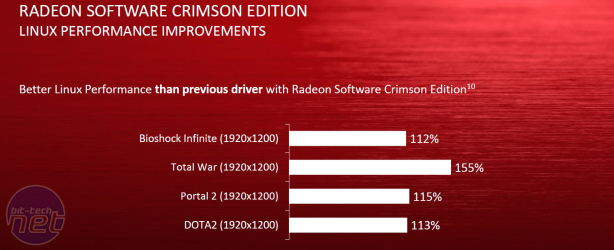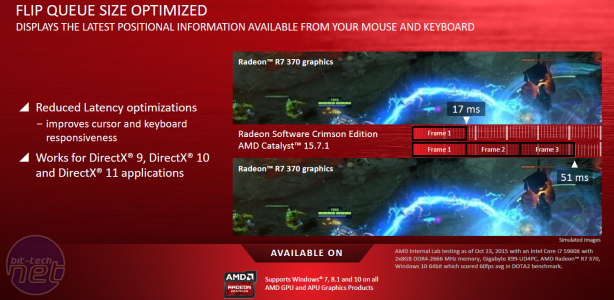
Besides improved stability and feature updates, one of the main reasons to stay up to date with graphics drivers is the improved performance they can draw from your hardware, especially in the latest games. Crimson is said to accelerate performance in DX12 games, but AMD has also pledged a new focus on improving performance in the latest titles. Linux hasn't been forgotten about either, with AMD claiming to have improved performance in certain scenarios here too. That said, in terms of a firm release schedule, AMD is being understandably conservative. 2015 saw three major WHQL driver releases and nine beta ones; for 2016, AMD says it is planning up to six major releases with additional beta ones, though it hasn't made any minimum commitments.
When Nvidia launched the GTX 950, it also introduced a latency reduction feature specifically targeting MOBA players, and AMD is now responding in Crimson with the Flip Queue Size feature. This has actually been available in previous ATI and AMD drivers as a registry tweak, but is now easily available through the main user interface. It essentially limits the number of pre-rendered frames to improve the responsiveness of mouse and keyboard commands and is available on DX9, DX10 and DX11 applications.
Efficiency is another focus for AMD. The company introduced its Frame Rate Target Control (FRTC) feature in July with Catalyst 15.7. The idea is simple – limit the number of frames your GPU is rendering in order to reduce its power consumption and thus its heat and noise, and it thus has more obvious applications in mobile products. With Crimson, AMD is extending support to DX9 products and increasing the available frame rate range to anything between 30 and 200fps. The new driver is also said to be more efficient and save more power on existing DX10 and DX11 applications when otherwise using the same settings and hardware.
FRTC is not the only area where efficiency optimisations have been made. AMD says that it has been able to reduce GPU power consumption by over 20 percent in certain video playback and gaming scenarios. That said, this only applies to the R7 350, R7 370, R9 380 series and R9 Fury series GPU, meaning AMD is exploiting something inherent to its latest GCN architecture.
That just about covers the latest feature, performance and efficiency updates available in the new Radeon Software Crimson driver. It should be available to download from AMD's website now, so if you're an AMD GPU or APU user do give it a go and share your thoughts here.
When Nvidia launched the GTX 950, it also introduced a latency reduction feature specifically targeting MOBA players, and AMD is now responding in Crimson with the Flip Queue Size feature. This has actually been available in previous ATI and AMD drivers as a registry tweak, but is now easily available through the main user interface. It essentially limits the number of pre-rendered frames to improve the responsiveness of mouse and keyboard commands and is available on DX9, DX10 and DX11 applications.
Efficiency is another focus for AMD. The company introduced its Frame Rate Target Control (FRTC) feature in July with Catalyst 15.7. The idea is simple – limit the number of frames your GPU is rendering in order to reduce its power consumption and thus its heat and noise, and it thus has more obvious applications in mobile products. With Crimson, AMD is extending support to DX9 products and increasing the available frame rate range to anything between 30 and 200fps. The new driver is also said to be more efficient and save more power on existing DX10 and DX11 applications when otherwise using the same settings and hardware.
FRTC is not the only area where efficiency optimisations have been made. AMD says that it has been able to reduce GPU power consumption by over 20 percent in certain video playback and gaming scenarios. That said, this only applies to the R7 350, R7 370, R9 380 series and R9 Fury series GPU, meaning AMD is exploiting something inherent to its latest GCN architecture.
That just about covers the latest feature, performance and efficiency updates available in the new Radeon Software Crimson driver. It should be available to download from AMD's website now, so if you're an AMD GPU or APU user do give it a go and share your thoughts here.

MSI MPG Velox 100R Chassis Review
October 14 2021 | 15:04












Want to comment? Please log in.